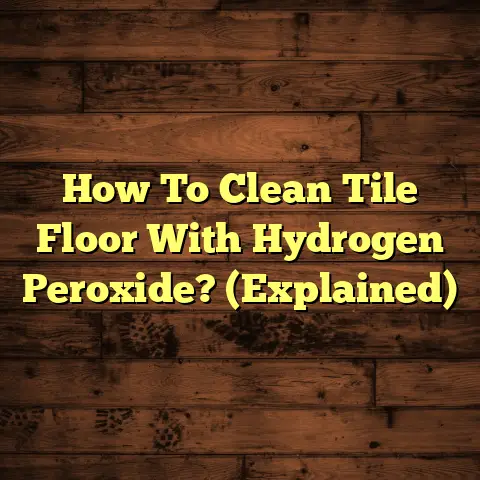Close Laminate Floor Gaps? (1 Hour Fix!)
And you know what? It’s often a super easy fix! I’m talking potentially a one-hour project. Plus, I’m all about making eco- conscious choices in my business, and I know many of you are too. So, we’ll touch on that aspect as well.
Let’s dive in!
Section 1: Understanding Laminate Flooring
So, what exactly is laminate flooring?
Think of it like a high-tech sandwich. It’s made of several layers, typically including a core board (often made of high-density fiberboard or HDF), a decorative layer (that beautiful wood- look image), and a wear layer on top that protects it all.
Benefits of Laminate:
- Durability: It can handle a lot of foot traffic and resists scratches.
- Easy Maintenance: A quick sweep and mop usually does the trick.
- Affordability: Generally cheaper than hardwood.
- Eco-Friendly Potential: This is key! Many manufacturers use recycled content and sustainable practices. Look for certifications like the Forest Stewardship Council (FSC) to ensure responsible sourcing.
Why the Gaps?
Okay, so if it’s so great, why do these annoying gaps appear?
Here’s the lowdown:
- Temperature Changes: Wood (and wood-based products like laminate) expands and contracts with temperature fluctuations.
- Humidity Levels: Similar to temperature, humidity causes expansion and contraction. Think of it like this: in the summer, it’s humid, planks expand, and in the winter, it’s dry, and planks contract.
- Subfloor Imperfections: If the subfloor (the floor underneath your laminate) isn’t perfectly level, it can put stress on the planks and lead to gaps.
- Improper Installation: This is a big one. If the planks aren’t properly locked together during installation, gaps are almost guaranteed to appear.
Section 2: Identifying Gaps in Laminate Flooring
Not all gaps are created equal. Let’s break down the different types:
- Small Gaps (Hairline Cracks): These are the most common. They’re usually less than 1/8 inch wide and often appear between planks. You might not even notice them at first!
- Large Gaps (Visible Separation): These are more noticeable, often wider than 1/8 inch. You can clearly see the separation between planks.
- Gaps Between Planks at Ends: These occur at the short ends of the planks, where they connect end-to-end.
- Gaps Along Walls (Expansion Gaps): These are supposed to be there! Laminate needs room to expand and contract, so installers leave a small gap (usually covered by baseboards) around the perimeter of the room. These aren’t the gaps we’re trying to fix.
Scenario Time!
Imagine this: It’s winter, and you’ve got the heat cranked up. You start noticing small gaps appearing between the planks in your living room. These are likely due to the dry air causing the laminate to contract.
Or, picture this: You’ve just moved into a new house, and you notice a large gap running the length of several planks. This could be a sign of subfloor imperfections or improper installation.
Section 3: Tools and Materials Needed for Fixing Gaps
Alright, let’s get down to business! Here’s what you’ll need in your gap- fixing arsenal:
Essential Tools:
- Tapping Block: This is a small,
rectangular block made of wood or
plastic. You use it to gently tap the
planks together without damaging them.
- Pro Tip: I prefer a tapping block made of hard plastic. It’s more durable than wood and less likely to splinter.
- Pull Bar: This is a metal bar with a hooked end. You use it to pull planks together in tight spaces, like along walls.
- Hammer: A standard hammer will do the trick. You’ll use it to tap the tapping block or pull bar.
- Pencil and Ruler/Measuring Tape: For marking and measuring.
- Putty Knife: For applying filler.
- Soft Cloth: For wiping away excess filler.
Materials You Might Need:
- Gap Filler Products: These come in
various forms, including:
- Laminate Floor Repair Kit: These kits usually include a color-matched filler and applicator.
- Wood Putty: This is a thicker filler that’s good for larger gaps. Make sure to choose a color that closely matches your flooring.
- Acrylic Caulk: This is a flexible filler that’s good for small gaps and areas where expansion and contraction are likely.
- Additional Laminate Planks (Optional): If the gaps are too large to fill, you might need to replace some planks.
- Wood Glue (Optional): For securing loose planks.
- Color-Matching Grout (Optional): For filling gaps, especially if you want a seamless look.
Eco-Friendly Considerations:
This is where we can make a difference!
- Look for Low-VOC Fillers: VOCs (volatile organic compounds) are chemicals that can off-gas into the air and cause health problems. Choose fillers that are labeled “low-VOC” or “zero-VOC.”
- Use Recycled or Reclaimed Wood Putty: Some manufacturers offer wood putty made from recycled wood fibers.
- Dispose of Waste Properly: Recycle any packaging and dispose of leftover fillers according to local regulations.
Section 4: Step-by-Step Guide to Closing Laminate Floor Gaps
Okay, let’s get those gaps closed! Here’s a detailed, step-by-step guide:
Step 1: Assess the Extent of the Gaps and Plan the Repair.
- Take a good look at the gaps. How wide are they? Where are they located? Are they consistent throughout the floor, or just in certain areas?
- Decide which method you’ll use to fix the gaps (tapping block, filler, or plank replacement).
- Consider the overall appearance of the floor. Do you want a perfect, seamless repair, or are you okay with a slightly visible patch?
Step 2: Gather All Necessary Tools and Materials.
- Make sure you have everything you need before you start. There’s nothing worse than getting halfway through a project and realizing you’re missing a crucial tool!
Step 3: Prepare the Area by Cleaning it Thoroughly.
- Vacuum or sweep the floor to remove any dirt, dust, or debris.
- Use a damp cloth to wipe down the area around the gaps.
- Make sure the floor is completely dry before proceeding.
Step 4: Use a Tapping Block and Hammer to Gently Nudge Planks Together.
- This is the easiest and often most effective method for closing small gaps.
- Place the tapping block against the edge of the plank next to the gap.
- Use the hammer to gently tap the tapping block, nudging the plank towards the gap.
- Repeat this process along the length of the gap, working your way from one end to the other.
- Important: Don’t hit the tapping block too hard! You could damage the planks. Use gentle, controlled taps.
- If you’re working in a tight space, use the pull bar to pull the planks together.
Step 5: If Gaps Persist, Apply an Appropriate Filler to Close the Gaps Securely.
- If the tapping block method doesn’t completely close the gaps, you’ll need to use a filler.
- Choose the appropriate filler based on the size of the gaps and the desired appearance.
- Apply the filler according to the manufacturer’s instructions.
- Use a putty knife to smooth the filler and remove any excess.
- Wipe away any excess filler with a soft cloth.
Step 6: Allow Any Filler to Dry as Per Product Instructions.
- This is crucial! Don’t walk on the repaired area until the filler is completely dry.
- The drying time will vary depending on the type of filler you use. Check the manufacturer’s instructions for specific drying times.
Step 7: Finish the Area, Ensuring a Seamless Look with the Rest of the Flooring.
- Once the filler is dry, you may need to sand it lightly to blend it in with the surrounding flooring.
- Use fine-grit sandpaper and sand in the direction of the wood grain.
- If necessary, apply a color-matching stain or sealant to further blend the repaired area with the rest of the floor.
Section 5: Quick Fixes for Temporary Solutions
Sometimes, you need a quick fix to tide you over until you can do a more thorough repair. Here are a couple of temporary solutions:
- Caulk for Small Gaps: Acrylic caulk
can be used to fill small gaps. It’s
easy to apply and relatively inexpensive. However, it’s not a permanent solution
and may need to be reapplied over time.
- Important: Choose a caulk that’s paintable so you can match it to the color of your flooring.
- Rugs or Furniture: Strategically placing rugs or furniture can help to hide unsightly gaps.
Remember: These are just temporary solutions. They won’t address the underlying cause of the gaps.
Section 6: Preventative Measures to Avoid Future Gaps
The best way to deal with gaps in laminate flooring is to prevent them from forming in the first place! Here are some tips:
- Proper Installation: This is the most important factor. Make sure the laminate is installed correctly, with the planks properly locked together. If you’re not comfortable installing the flooring yourself, hire a professional.
- Acclimation: Allow the laminate planks to acclimate to the room’s temperature and humidity for at least 48 hours before installation. This will help to minimize expansion and contraction after installation.
- Maintain Consistent Temperature and Humidity: Avoid extreme temperature and humidity fluctuations. Use a humidifier in the winter to add moisture to the air.
- Use Eco-Friendly Cleaning Products: Avoid harsh chemicals that can damage the flooring. Choose cleaning products that are specifically designed for laminate floors and are labeled “eco- friendly.”
- Regular Cleaning: Sweep or vacuum the floor regularly to remove dirt and debris. This will help to prevent scratches and other damage.
- Use Furniture Pads: Place furniture pads under the legs of furniture to protect the flooring from scratches and dents.
A Note on Acclimation: I can’t stress this enough! I’ve seen so many flooring problems that could have been avoided simply by properly acclimating the material. Don’t skip this step!
Section 7: Conclusion
Maintaining your laminate flooring is more than just about aesthetics; it’s about sustainability too. By choosing eco-friendly materials, practicing proper maintenance, and addressing issues like gaps promptly, you’re extending the life of your flooring and reducing your environmental impact.
So, be proactive! Take care of your floors, and they’ll take care of you (and the planet!).
Call to Action:
Have you tackled any laminate floor gap repairs yourself? I’d love to hear about your experiences! Share your tips and tricks in the comments below or on social media using #[YourBrand]Flooring.
And be sure to check out my other articles for more eco-friendly home improvement tips!





